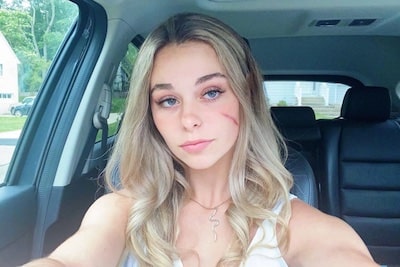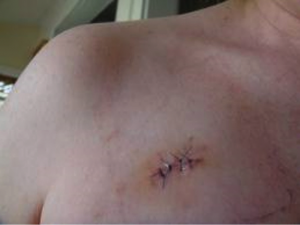For almost two years, Annie Bonelli, who is known as “Scar Girl” on TikTok, has been questioned by viewers about the scar on her face. For the past several months, the questioning has grown as TikTok viewers are trying to determine if the scar is real or fake. The new questions about the scar came about once the long, linear scar on the cheek started to change in length, shape, and color.
#ScarGirl – Scandal or Not?
Videos featuring the hashtag #ScarGirl have been viewed over 359-million times on TikTok and the discussion surrounding Bonelli has been expanded by creating the hashtag, #ScarGirlExposed. Some of the videos include breakdowns of her video to feature frame-by-frame examinations including people accusing her of using makeup to darken the look of her scar. There are videos that make fun of her scar, but Bonelli says she has “thick skin” when it comes to posts on social media.
The eighteen-year-old told NBC News, “My parents always told me, ‘Don’t say things about people’s bodies, don’t make comments about other people, don’t say things about what other people can’t control.’ I feel like on social media people get so comfortable, especially with influencers in general, to make comments on things because they don’t always view them as real people. Like, I’m a real person.”

Scar Girl – Possible Reason for the Interest in Her Suspected Scandal
Brooke Erin Duffy, who is an associate professor of communication at Cornell University, says the ongoing interest in the story of the scar is an example of social media “authenticity policing.” According to Duffy, this occurs when people continuously view the self-presentation of a person as being deceptive or fake. Online audiences are often drawn to influencers who seem to be authentic which means they become angry when they think a creator is creating content for the wrong reasons.
Bonelli, whose handle on TikTok is @wtmab, said she used to avoid talking about her scar until the recent interest in its appearance. She has over 750,000 followers and says she was trying not to mention the scar because “it’s not who I am. So I think it honestly just sparked more curiosity with people.”
Her attempts to address the gossip about her scar have been met with skepticism by some TikTok users in the comment section of her videos. Bonelli said she has learned to accept the fact that “you can’t please everyone. I’m continuing to live my life, especially in spite of the hate. There’s people that are always going to say something, and I shouldn’t let that faze me.”
Scar Girl – When Did the Scat First Appear?
According to Bonelli, her scar appeared when she was fifteen years of age and a junior in high school. She does not want to share any specific details about how she got the scar as she considers it to be a personal subject. “Looking in the mirror, sometimes it can be hard because I know exactly where it’s from. But at the same time, I feel like in a way it’s empowering. It’s like, you know, I got through that.”
While the scar started to fade after a few months (as seen in some of her 2021 videos), its appearance began to worsen after she tried to use a topical treatment to fade the initial scar. Instead, she got a chemical burn which created a new wound located on top of the scar.
She described the chemical burn as “bubbly and bloody and gross. That turned into a new wound on top of it, which is why [the scar became significantly longer, because I just sloppily put it on.” The topical treatment did not come from a doctor, and she also delayed seeing a doctor after the chemical burn because of a fear of doctors. She did start to see a dermatologist in August of last year who is putting her on a new treatment to fade the scar.
Scar Girl – Attempts to Prove the Scar is Real
Since the scar on her face involves two separate injuries, Bonelli says people don’t understand that fact and that is part of the reason they are so interested in her scar.
In January of this year, she made a video wiping her scar with a makeup remover in order to prove the authenticity of the scar. However, the video did not succeed in changing the mind of her doubters. Some commentators demanded she scrub the scar “really hard” to prove it is real while others do not believe her scar could change shape or become darker in appearance.
Anyone interested in the healing of a scar should know that scars can heal either lighter or darker and it depends on the specific circumstances of the treatment or injury. If the scar is exposed to sunlight or is injured due to trauma, the scar can become darker in color.
Bonelli has received some support online including support from some skeptics of her story who feel that others have taken the debate over the scar too far by showing hate in her comments section.
Bonelli has made the choice to remain positive about her situation as it has given her a platform and allowed her to receive messages of support from those with similar scars and experiences. She wants to encourage people to embrace their scars and to also use her platform to advocate for body positivity and domestic violence awareness.

 Underwood is considered to be one of the most beautiful women in country music so her fans were alarmed when she announced the fall. Her injuries included a broken wrist and over 40 stitches in her face thanks to a gash around her upper lip. According to Underwood, she was taking her dogs out when she tripped after missing a step. She tried to catch herself but was unable to stop herself from taking a tumble.
Underwood is considered to be one of the most beautiful women in country music so her fans were alarmed when she announced the fall. Her injuries included a broken wrist and over 40 stitches in her face thanks to a gash around her upper lip. According to Underwood, she was taking her dogs out when she tripped after missing a step. She tried to catch herself but was unable to stop herself from taking a tumble.

 Scar tissue is a beauty concern for many people. When the natural skin has been damaged beyond its first layer, scar tissue is the tissue which replaces it. Scar tissue is the same tissue as healthy skin even though it looks different. This is because the fibers are arranged differently within the tissue.
Scar tissue is a beauty concern for many people. When the natural skin has been damaged beyond its first layer, scar tissue is the tissue which replaces it. Scar tissue is the same tissue as healthy skin even though it looks different. This is because the fibers are arranged differently within the tissue. While moles are generally harmless, there are times that moles can be irregular in shape as well as continue to grow on a consistent basis. This means there might be something happening in your body that needs to be examined by a doctor. While the mole itself might be harmless, there are many people who want to decrease the chances of the mole becoming harmful by having it removed.
While moles are generally harmless, there are times that moles can be irregular in shape as well as continue to grow on a consistent basis. This means there might be something happening in your body that needs to be examined by a doctor. While the mole itself might be harmless, there are many people who want to decrease the chances of the mole becoming harmful by having it removed.